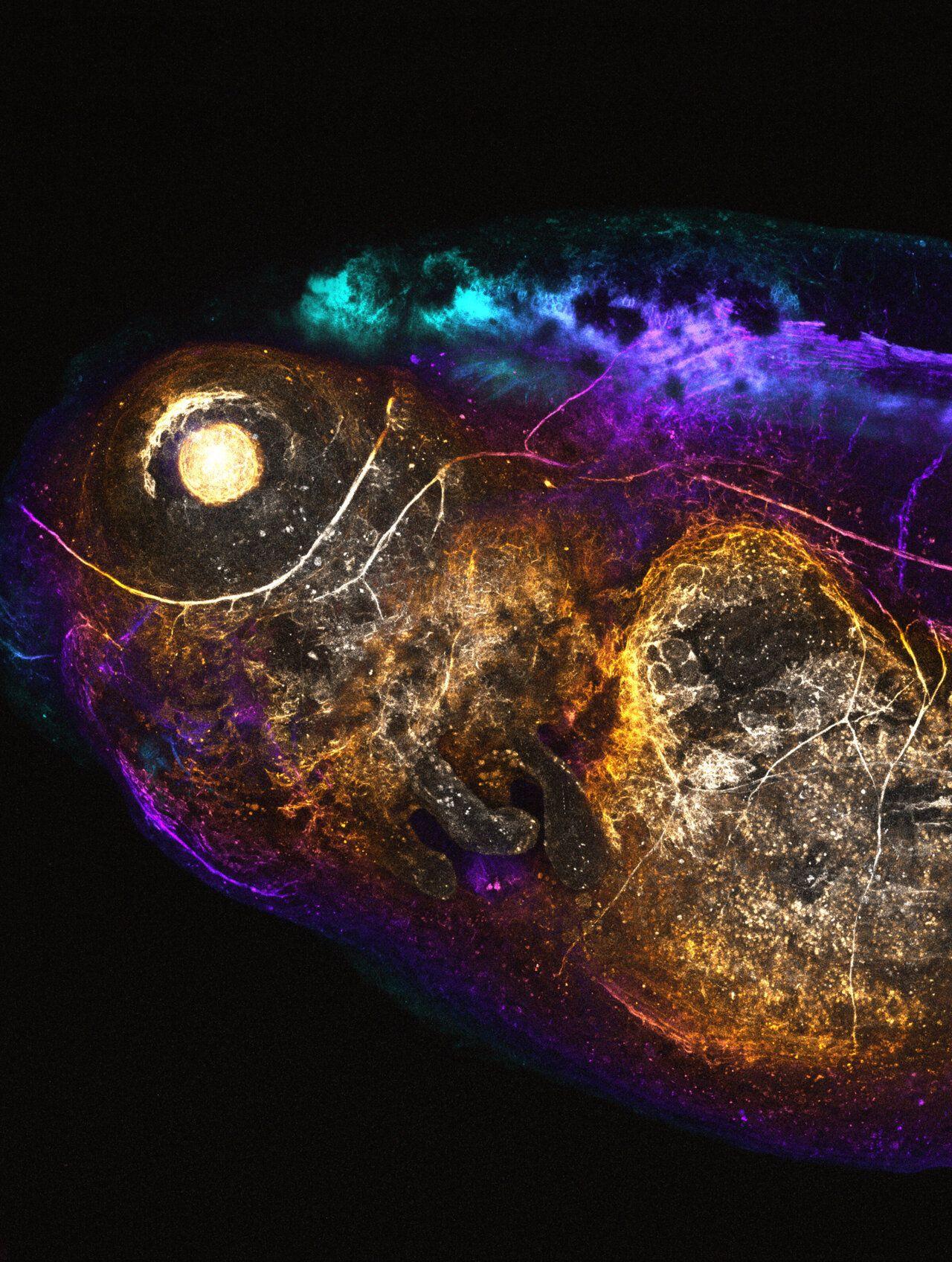CRISPR-Cas13: A Revolutionary Breakthrough in RNA-Targeted Therapies
2 Sources
2 Sources
[1]
CRISPR-Cas13 emerges as a game changer in RNA-targeted therapies
Nanjing Agricultural University The Academy of ScienceSep 25 2024 In recent years, the scientific community has made significant strides in the field of gene editing, particularly through the development of the CRISPR (Clustered Regularly Interspaced Short Palindromic Repeats) systems. In 2020, the Nobel Prize in Chemistry was awarded to the scientists for the discovery of CRISPR-Cas9 system, a revolutionary genome editing technology that advanced DNA therapeutics. Subsequently, the CRISPR-Cas13 system has emerged as a potential tool to identify and rectify errors in RNA sequences. CRISPR-Cas13 is a novel technology is specifically engineered for virus detection and RNA-targeted therapeutics. The CRISPR RNA (CrRNA) targets specific and non-specific RNA sequences, and Cas13 is an effector protein that undergoes conformational changes and cleaves the target RNA. This RNA-targeting system holds tremendous promise for therapeutics and presents a revolutionary tool in the landscape of molecular biology. Now, in a recently published BioDesign Research study, a team of researchers led by Professor Yuan Yao from ZJU-Hangzhou Global Scientific and Technological Innovation Center, Zhejiang University, China has elucidated the latest research trends of CRISPR-Cas13 in RNA-targeted therapies. Talking about this paper, which was published online on 6 September 2024, in Volume 6 of the journal, Prof. Yao says, "By focusing on RNA-;the intermediary between DNA and proteins-;CRISPR-Cas13 allows scientists to temporarily manipulate gene expression without inducing permanent changes to the genome. This flexibility makes it a safer option in scenarios where genome stability is critical ." RNA plays a central role in carrying genetic information from DNA to protein-synthesizing machinery, and also regulates gene expression and participates in numerous cellular processes. Defects in RNA splicing or mutations can lead to a wide variety of diseases, ranging from metabolic disorders to cancer. A point mutation occurs when a single nucleotide is erroneously inserted, deleted, or changed. CRISPR-Cas13 plays a role in identifying and correcting these mutations by employing REPAIR (RNA editing for programmable A-to-I replacement) and RESCUE (RNA editing for specific C-to-U exchange) mechanisms. Explaining the applications of Cas13-based gene editors, Prof. Yao adds, "The mxABE editor, for example, can be used to correct a nonsense mutation linked with Duchenne muscular dystrophy that can be corrected with mxABE. This approach has proved high editing efficiency, restoring dystrophin expression to levels more than 50% of those of the wild type." CRISPR-Cas13 can rectify unusual splicing events. Demethylase is an enzyme that plays a crucial role in post-transcriptional modification (PTM), a process that occurs after transcription and precedes protein production. Harnessing knowledge about splicing events, and understanding the role of demethylases with the help of CRISPR-Cas13 can help scientists to develop targeted and personalized therapies. Similarly, CRISPR-Cas13 machinery can be applied to alter, upregulate, or downregulate translation. "One of the most significant recent advancements in the CRISPR-Cas13 field is the integration of artificial intelligence (AI) to enhance its precision and efficiency ," says Prof. Yao. The success of RNA-targeting CRISPR tools depends on multiple factors, including the guide RNA sequence, the accessibility of the target RNA, and the secondary structure of the RNA molecule. The CRISPR-Cas13 system has wide clinical applications, such as diagnostics for RNA viruses, RNA imaging, RNA-base editing, RNA epigenome editing, and therapeutic interventions. Off-target of CRISPR-Cas13 and the large size of the delivery machinery are some of the clinical hurdles slowing down its clinical implementation. But combining molecular techniques with AI can improve efficiency. AI algorithms have the power to predict and optimize CRISPR-Cas13 delivery outcomes. Going further, CRISPR-Cas13 systems are likely to continue their rapid evolution. As researchers refine the technology, there is potential for its use in an even wider range of therapeutic applications, from antiviral treatments-;such as targeting SARS-CoV-2-;to personalized medicine approaches for genetic diseases. Finally, the advent of CRISPR-Cas13 has undoubtedly revolutionized RNA editing, offering a powerful tool for addressing some of the most challenging diseases of our time. Hopefully, with the ongoing improvements in specificity, delivery, and AI integration, CRISPR-Cas13 could pave the way for a new era of RNA-targeted therapies. Nanjing Agricultural University The Academy of Science Journal reference: Zhu, G., et al. (2024) CRISPR-Cas13: Pioneering RNA Editing for Nucleic Acid Therapeutics. BioDesign Research. doi.org/10.34133/bdr.0041.
[2]
CRISPR-Cas13: A New Frontier in RNA-Editing with R | Newswise
Newswise -- In recent years, the scientific community has made significant strides in the field of gene editing, particularly through the development of the CRISPR (Clustered Regularly Interspaced Short Palindromic Repeats) systems. In 2020, the Nobel Prize in Chemistry was awarded to the scientists for the discovery of CRISPR-Cas9 system, a revolutionary genome editing technology that advanced DNA therapeutics. Subsequently, the CRISPR-Cas13 system has emerged as a potential tool to identify and rectify errors in RNA sequences. CRISPR-Cas13 is a novel technology is specifically engineered for virus detection and RNA-targeted therapeutics. The CRISPR RNA (CrRNA) targets specific and non-specific RNA sequences, and Cas13 is an effector protein that undergoes conformational changes and cleaves the target RNA. This RNA-targeting system holds tremendous promise for therapeutics and presents a revolutionary tool in the landscape of molecular biology. Now, in a recently published BioDesign Research study, a team of researchers led by Professor Yuan Yao from ZJU-Hangzhou Global Scientific and Technological Innovation Center, Zhejiang University, China has elucidated the latest research trends of CRISPR-Cas13 in RNA-targeted therapies. Talking about this paper, which was published online on 6 September 2024, in Volume 6 of the journal, Prof. Yao says, "By focusing on RNA -- the intermediary between DNA and proteins -- CRISPR-Cas13 allows scientists to temporarily manipulate gene expression without inducing permanent changes to the genome. This flexibility makes it a safer option in scenarios where genome stability is critical ." RNA plays a central role in carrying genetic information from DNA to protein-synthesizing machinery, and also regulates gene expression and participates in numerous cellular processes. Defects in RNA splicing or mutations can lead to a wide variety of diseases, ranging from metabolic disorders to cancer. A point mutation occurs when a single nucleotide is erroneously inserted, deleted, or changed. CRISPR-Cas13 plays a role in identifying and correcting these mutations by employing REPAIR (RNA editing for programmable A-to-I replacement) and RESCUE (RNA editing for specific C-to-U exchange) mechanisms. Explaining the applications of Cas13-based gene editors, Prof. Yao adds, "The mxABE editor, for example, can be used to correct a nonsense mutation linked with Duchenne muscular dystrophy that can be corrected with mxABE. This approach has proved high editing efficiency, restoring dystrophin expression to levels more than 50% of those of the wild type." CRISPR-Cas13 can rectify unusual splicing events. Demethylase is an enzyme that plays a crucial role in post-transcriptional modification (PTM), a process that occurs after transcription and precedes protein production. Harnessing knowledge about splicing events, and understanding the role of demethylases with the help of CRISPR-Cas13 can help scientists to develop targeted and personalized therapies. Similarly, CRISPR-Cas13 machinery can be applied to alter, upregulate, or downregulate translation. "One of the most significant recent advancements in the CRISPR-Cas13 field is the integration of artificial intelligence (AI) to enhance its precision and efficiency ," says Prof. Yao. The success of RNA-targeting CRISPR tools depends on multiple factors, including the guide RNA sequence, the accessibility of the target RNA, and the secondary structure of the RNA molecule. The CRISPR-Cas13 system has wide clinical applications, such as diagnostics for RNA viruses, RNA imaging, RNA-base editing, RNA epigenome editing, and therapeutic interventions. Off-target of CRISPR-Cas13 and the large size of the delivery machinery are some of the clinical hurdles slowing down its clinical implementation. But combining molecular techniques with AI can improve efficiency. AI algorithms have the power to predict and optimize CRISPR-Cas13 delivery outcomes. Going further, CRISPR-Cas13 systems are likely to continue their rapid evolution. As researchers refine the technology, there is potential for its use in an even wider range of therapeutic applications, from antiviral treatments -- such as targeting SARS-CoV-2 -- to personalized medicine approaches for genetic diseases. Finally, the advent of CRISPR-Cas13 has undoubtedly revolutionized RNA editing, offering a powerful tool for addressing some of the most challenging diseases of our time. Hopefully, with the ongoing improvements in specificity, delivery, and AI integration, CRISPR-Cas13 could pave the way for a new era of RNA-targeted therapies. Guanglin Zhu 1†, Xinzhi Zhou 2,3†, Mingzhang Wen 1,4,5*, Jianjun Qiao 1,4,5*,Guo Li2,3,6*, and Yuan Yao 2,3,4 Affiliations 1School of Chemical Engineering and Technology, Tianjin University, Tianjin 300072, China. 2ZJU-HangzhouGlobal Scientific and Technological Innovation Center, Zhejiang University, Hangzhou, Zhejiang 311200,China. 3College of Chemical and Biological Engineering, Zhejiang University, Hangzhou, Zhejiang 310027,China. 4Zhejiang Institute of Tianjin University, Shaoxing 312300, China. 5Frontiers Science Centerfor Synthetic Biology (Ministry of Education), Tianjin University, Tianjin 300072, P. R. China.
Share
Share
Copy Link
CRISPR-Cas13, a novel RNA-editing tool, is emerging as a game-changer in the field of genetic therapies. This groundbreaking technology offers new possibilities for treating various diseases by targeting RNA molecules.

The Rise of CRISPR-Cas13
CRISPR-Cas13, a revolutionary gene-editing tool, is making waves in the scientific community as a potential game-changer for RNA-targeted therapies. Unlike its predecessor CRISPR-Cas9, which focuses on DNA editing, CRISPR-Cas13 specifically targets RNA molecules, opening up new avenues for treating a wide range of diseases
1
.Mechanism and Advantages
CRISPR-Cas13 functions by utilizing guide RNA (gRNA) to locate and modify specific RNA sequences. This precision allows for the alteration of gene expression without making permanent changes to the genome. The technology offers several advantages over traditional gene therapy approaches:
- Reversibility: Unlike DNA editing, RNA modifications are temporary and can be adjusted or reversed if needed.
- Reduced off-target effects: CRISPR-Cas13 demonstrates high specificity, minimizing unintended modifications.
- Versatility: It can be applied to various RNA types, including mRNA, long non-coding RNA, and circular RNA
2
.
Therapeutic Potential
The applications of CRISPR-Cas13 in medicine are vast and promising. Researchers are exploring its use in treating genetic disorders, cancer, and viral infections. Some potential applications include:
- Genetic disorders: Correcting RNA mutations associated with diseases like cystic fibrosis and muscular dystrophy.
- Cancer therapy: Targeting cancer-specific RNA sequences to inhibit tumor growth.
- Antiviral treatments: Developing therapies against RNA viruses such as influenza and coronavirus
1
.
Related Stories
Challenges and Future Directions
While CRISPR-Cas13 shows immense promise, several challenges need to be addressed before widespread clinical application:
- Delivery methods: Developing efficient ways to deliver the CRISPR-Cas13 system to target cells.
- Off-target effects: Further reducing potential unintended modifications.
- Regulatory considerations: Establishing guidelines for the safe use of RNA-editing technologies in humans
2
.
As research progresses, scientists are optimistic about the potential of CRISPR-Cas13 to revolutionize personalized medicine and provide new treatment options for previously untreatable conditions. The coming years are likely to see increased clinical trials and potential breakthroughs in RNA-targeted therapies, marking a new era in genetic medicine.
References
Summarized by
Navi
[1]
Related Stories
AI-Powered 'Pythia' Tool Revolutionizes Precision in CRISPR Gene Editing
13 Aug 2025•Science and Research

CRISPR-GPT: AI-Powered Gene Editing Assistant Accelerates Drug Development
17 Sept 2025•Science and Research

AI Breakthrough: Designing Synthetic DNA Switches for Precise Gene Control
24 Oct 2024•Science and Research

Recent Highlights
1
Google launches Gemini 3 Flash as default AI model, delivering speed with Pro-grade reasoning
Technology

2
OpenAI launches GPT Image 1.5 as AI image generator war with Google intensifies
Technology

3
OpenAI launches ChatGPT app store, opening doors for third-party developers to build AI-powered apps
Technology





